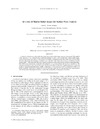Identificador persistente para citar o vincular este elemento:
https://accedacris.ulpgc.es/jspui/handle/10553/51979
| Campo DC | Valor | idioma |
|---|---|---|
| dc.contributor.author | Borge, José C.Nieto | en_US |
| dc.contributor.author | Rodríquez Rodríguez, Germán | en_US |
| dc.contributor.author | Hessner, Katrin | en_US |
| dc.contributor.author | González, Paloma Izquierdo | en_US |
| dc.date.accessioned | 2018-11-25T16:24:47Z | - |
| dc.date.available | 2018-11-25T16:24:47Z | - |
| dc.date.issued | 2004 | en_US |
| dc.identifier.issn | 0739-0572 | en_US |
| dc.identifier.uri | https://accedacris.ulpgc.es/handle/10553/51979 | - |
| dc.description.abstract | A method to estimate sea surface elevation maps from marine radar image sequences is presented. This method is the extension of an existing inverse modeling technique to derive wave spectra from marine radar images, which assumes linear wave theory with temporal stationarity and spatial homogeneity of the observed sea surface elevation. The proposed technique to estimate wave elevation maps takes into account a modulation transfer function (MTF), which describes the radar imaging mechanisms at grazing incidence and horizontal polarization. This MTF is investigated and empirically determined by wave measurements and numerical simulations. The numerical simulations show that shadowing is the dominant effect in the radar imaging mechanism at grazing incidence and horizontal polarization. Further comparisons of wave spectra, as well as comparisons of the wave height probability distributions obtained by the wave elevation maps and the corresponding buoy measurements with the theoretical Rayleigh distribution, confirm the applicability of the proposed method. | en_US |
| dc.language | eng | en_US |
| dc.publisher | 0739-0572 | - |
| dc.relation.ispartof | Journal of Atmospheric and Oceanic Technology | en_US |
| dc.source | Journal of Atmospheric and Oceanic Technology [ISSN 0739-0572], v. 21, p. 1291-1300 | en_US |
| dc.subject | 2510 Oceanografía | en_US |
| dc.subject.other | Marine radar images | en_US |
| dc.subject.other | Surface wave analysis | en_US |
| dc.title | Inversion of marine radar images for surface wave analysis | en_US |
| dc.type | info:eu-repo/semantics/Article | en_US |
| dc.type | Article | en_US |
| dc.identifier.doi | 10.1175/1520-0426(2004)021<1291:IOMRIF>2.0.CO;2 | |
| dc.identifier.scopus | 3042815107 | - |
| dc.identifier.isi | 000223215900014 | |
| dc.contributor.authorscopusid | 6603018398 | - |
| dc.contributor.authorscopusid | 7203006681 | - |
| dc.contributor.authorscopusid | 6603006412 | - |
| dc.contributor.authorscopusid | 56343203800 | - |
| dc.description.lastpage | 1300 | en_US |
| dc.description.firstpage | 1291 | en_US |
| dc.relation.volume | 21 | en_US |
| dc.investigacion | Ciencias | en_US |
| dc.type2 | Artículo | en_US |
| dc.contributor.daisngid | 1867514 | |
| dc.contributor.daisngid | 2230270 | |
| dc.contributor.daisngid | 1597823 | |
| dc.contributor.daisngid | 30725702 | |
| dc.utils.revision | Sí | en_US |
| dc.contributor.wosstandard | WOS:Borge, JCN | |
| dc.contributor.wosstandard | WOS:Rodriguez, GR | |
| dc.contributor.wosstandard | WOS:Hessner, K | |
| dc.contributor.wosstandard | WOS:Gonzalez, PI | |
| dc.date.coverdate | Agosto 2004 | |
| dc.identifier.ulpgc | Sí | es |
| dc.description.jcr | 1,7 | |
| dc.description.jcrq | Q1 | |
| dc.description.scie | SCIE | |
| item.grantfulltext | open | - |
| item.fulltext | Con texto completo | - |
| crisitem.author.dept | GIR IUNAT: Física marina y teledetección aplicada | - |
| crisitem.author.dept | IU de Estudios Ambientales y Recursos Naturales | - |
| crisitem.author.dept | Departamento de Física | - |
| crisitem.author.parentorg | IU de Estudios Ambientales y Recursos Naturales | - |
| crisitem.author.fullName | Rodríguez Rodríguez, Germán Alejandro | - |
| Colección: | Artículos | |
Citas SCOPUSTM
316
actualizado el 08-jun-2025
Citas de WEB OF SCIENCETM
Citations
210
actualizado el 06-mar-2022
Visitas
138
actualizado el 09-nov-2024
Descargas
349
actualizado el 09-nov-2024
Google ScholarTM
Verifica
Altmetric
Comparte
Exporta metadatos
Los elementos en ULPGC accedaCRIS están protegidos por derechos de autor con todos los derechos reservados, a menos que se indique lo contrario.
